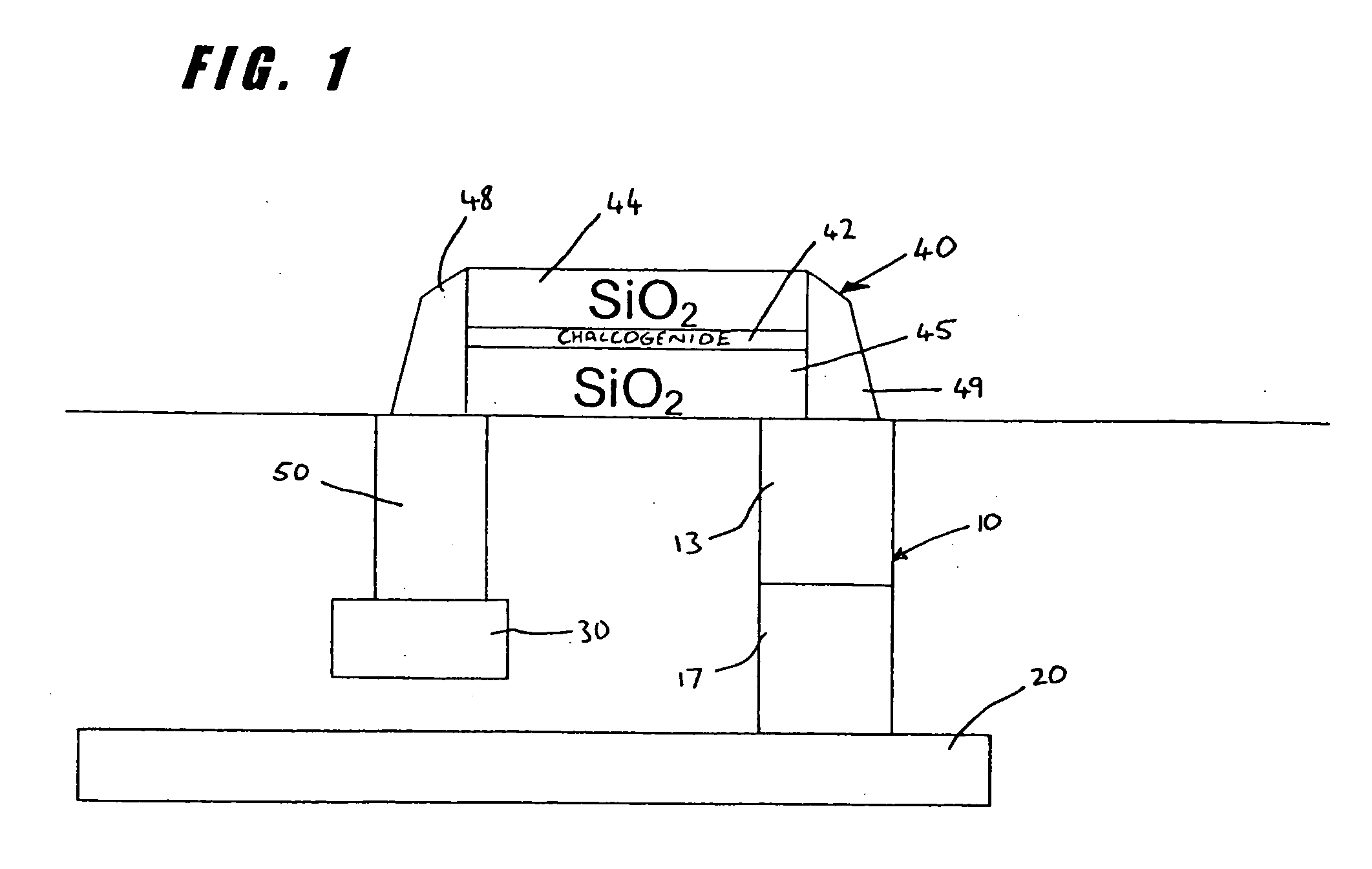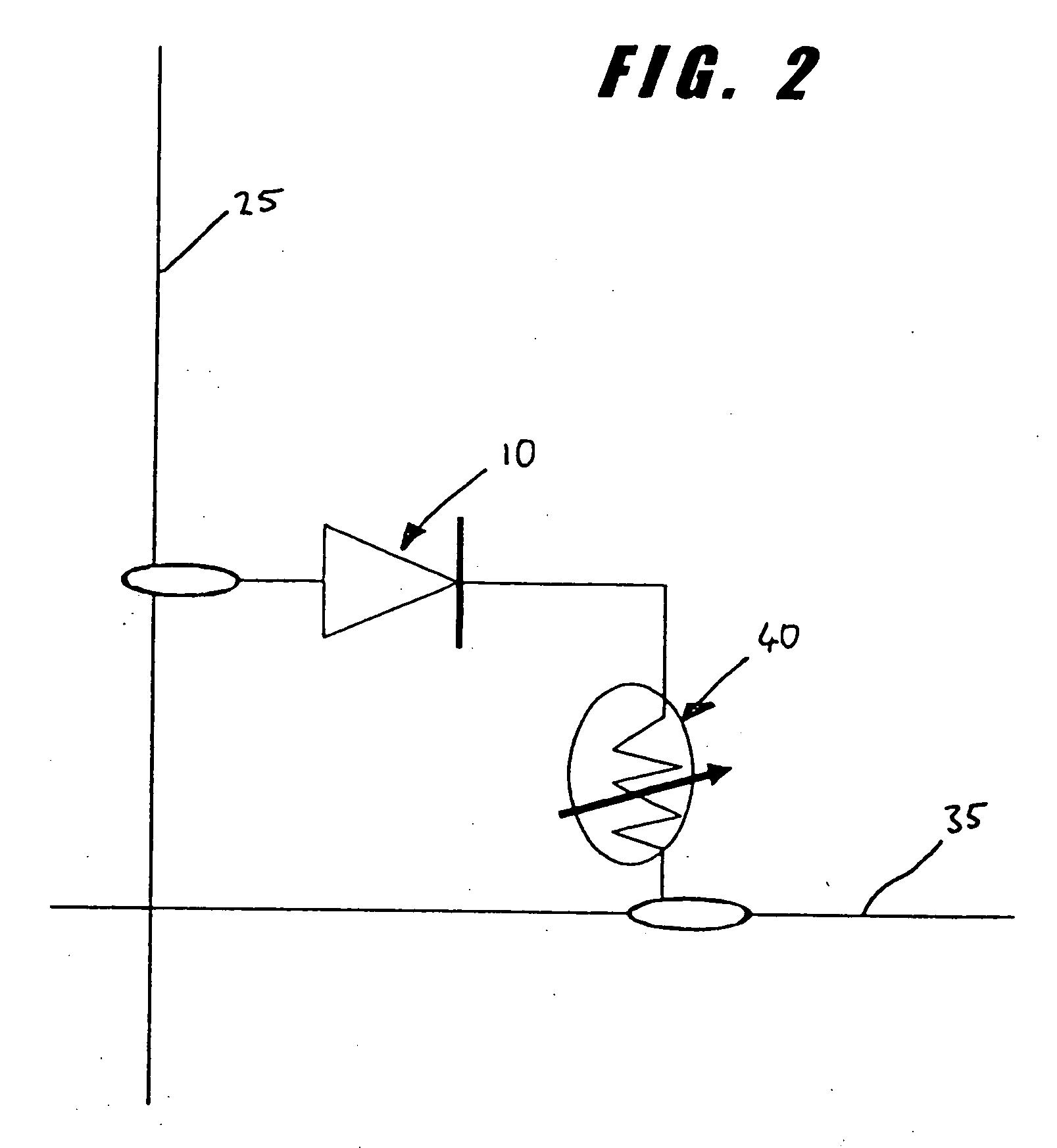Thin film phase-change memory
a phase-change memory and thin film technology, applied in the field of thin film phase-change memories, can solve the problems of difficult material placement into ultra-small holes, difficult to drive chalcogenide phase-change memories, and difficult to drive cmos circuits, etc., to achieve the effect of reducing current requirements, reducing cross-sectional area, and being easy to driv
- Summary
- Abstract
- Description
- Claims
- Application Information
AI Technical Summary
Benefits of technology
Problems solved by technology
Method used
Image
Examples
first embodiment
[0036]FIG. 1 illustrates how the chalcogenide memory cell of the present invention addresses these problems, wherein the chalcogenide structure 42 is implemented horizontally, rather than vertically. The chalcogenide structure 42 has an arbitrary length that is completely controllable without requiring, for example, thick layers of silicon dioxide. Instead of tapering down through a pore in the silicon dioxide layer, the chalcogenide structure 42 has a cross-sectional area that can be relatively consistent throughout the length of the chalcogenide structure 42.
[0037] This thin film process of chalcogenide deposition can result in a thin horizontal chalcogenide layer that may be not only thinner than vertical pores lithographically achievable through silicon dioxide, but also relatively uniform. The iso-etching process can create a relatively narrow horizontal chalcogenide structure 42, which can be narrower than that achievable though vertical pores of silicon-dioxide lithography. C...
third embodiment
[0064]FIG. 7 is a schematic diagram depicting a chalcogenide memory cell 240, in accordance with the present invention as depicted in FIG. 6. The selecting transistor 220 is used to select the current through the chalcogenide memory cell 240. The word line 225, controlled by a CMOS circuit (not shown), does not have to carry currents large enough to write to a chalcogenide memory cell 240. The word line 225 need only carry the negligible current necessary to switch the selecting transistor 220 on.
[0065] As shown in FIG. 7, the current that is used to write to the chalcogenide memory cell 240 is obtained from a drive line 265, not from the word line as in the previous embodiments of the present invention. The drive line 265 is, for example, obtained from a current buffer (not shown) that is capable of generating relatively large currents. The drive line 265 provides a current that passes through the selecting transistor 220 to the chalcogenide memory cell 240 when the word line 225 h...
fourth embodiment
[0069]FIG. 13A is a top plan schematic representation of a cell formation flow process, and FIG. 13B is a cross-sectional view of FIG. 13A, in accordance with the present invention. In a first step, a tungsten plug structure 310 is implemented on a silicon dioxide substrate. The tungsten structure may be another structure, such as a p-poly structure or a diode. In a second step, an oxide layer / chalcogenide / oxide sandwich structure is implemented onto the result of the first step. The oxide layer may be deposited using CVD methods and the chalcogenide is deposited using sputtering methods. In a third step, the sandwich structure is patterned in accordance with photolithography (i.e., lithography) techniques. A pattern is etched in the oxide layer. The pattern need not be deep, since only shallow trenches are desired in a preferred embodiment. In a fourth step, the chalcogenide layer is iso-etched, removing substantially all of the chalcogenide except where the chalcogenide is placed ...
PUM
 Login to View More
Login to View More Abstract
Description
Claims
Application Information
 Login to View More
Login to View More - R&D
- Intellectual Property
- Life Sciences
- Materials
- Tech Scout
- Unparalleled Data Quality
- Higher Quality Content
- 60% Fewer Hallucinations
Browse by: Latest US Patents, China's latest patents, Technical Efficacy Thesaurus, Application Domain, Technology Topic, Popular Technical Reports.
© 2025 PatSnap. All rights reserved.Legal|Privacy policy|Modern Slavery Act Transparency Statement|Sitemap|About US| Contact US: help@patsnap.com



